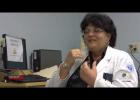Health Rights Clinic Medical Legal Partnership
Law schools have traditionally failed to adequately prepare graduates to assume their professional role. Our innovative, interdisciplinary, medical-legal course rectifies this by fully immersing law students in their role as advocates for under-served individuals and populations. Our students develop core competencies through repetitive practice and experience. They also forge their professional identity and develop ethical judgment through these experiences and the contrasting professional identities they encounter and explore in the medical field.
-
Video: We're Trained Differently, but Both Have Roots in Advocacy (Medical Professor Perspectives)
-
Video: The Real World Doesn't Happen One Subject at a Time (Student Perspectives)
-
Law Clinics and Students as First Responders: CLEA Award Nomination
-
The Client’s Perspective on the Initial Interview (Law Review Article)
-
Planning for the Future: Helping Patients Make Enforceable Long-Term Decisions (PowerPoint)
Since 2005, the Health Rights Clinic (formerly Health and Elder Law Clinic) as been an in-house live client clinical course at the University of Miami Law School, offered to second and third year law students. The clinic is a Medical Legal Partnership (MLP) with the University of Miami Miller School of Medicine, providing legal services to patients in the HIV and other Clinics, as well as the VA Hospital. The high volume “teaching hospital” model integrates legal assistance as a vital component of solving the health problems of vulnerable populations. The law students become members of the healthcare team and assist patients with legal issues, such as disability, public benefits, advance directives, immigration relief, and unhealthy housing conditions. We provide hands-on, multidisciplinary experience designed to make law students practice-ready. Law student clinicians are paired with medical residents in an interdisciplinary enterprise that assesses and meets the medical and legal needs of patient-clients. The medical and legal clinicians are cross-trained in each others’ disciplines to the extent needed to engage in the joint clinical practice and conduct the client/patient intake/encounter together. Students participating in this experiential “teaching hospital” will be prepared to begin their journey as lifetime legal learners. From the first day, they begin their practice with multiple real clients in real case situations, making strategic decisions under pressure. This course provides students with a framework to begin to develop professional identity and judgment informed by rich experience. The multidisciplinary model provides different professional perspectives and teaches collaborative problem-solving skills.
Overview. Our learning goals are set forth in our Clinic Handbook and discussed with students regularly. They represent the multi-faceted dimensions of being an effective lawyer: (1) Conduct an empathetic client-centered interview that accurately identifies client goals and needs, (2) Be able to marshal correct and necessary facts for effective representation, (3) Create and maintain well-documented electronic and paper client files, (4) Develop a case theory and a case plan for all cases, (5) Conduct a hearing, if necessary, with the ability to deviate from the plan and think on their feet, (6) Communicate and advocate effectively in writing and orally, (7) Conduct thorough and accurate legal research, (8) Become a reflective practitioner, (9) Become an effective problem-solver, (10) Work as part of a team, (11) Organize, manage, and triage your case load, (12) Conduct yourself in a professional manner with integrity and honesty at all times, (13) Treat clients, lawyers, judges, and staff with respect, (14) Demonstrate sensitivity to race and cultural diversity issues, (15) Recognize and resolve ethical issues, and (16) Exhibit diligence and punctuality. In 2011, we expanded the Clinic to medical students as well as residents. Law students are required to conduct weekly live client intakes at our various hospital sites with medical partners. The class component is composed of a weekly academic half-day, which includes lectures and skills training sessions. The class component covers substantive topics, including the social determinants of health, disability, advance directives, public benefits and guardianship, competence, and probate issues, as well as professionalism, competency, confidentiality, and cross-disciplinary ethics. We have learned that many of our law students have not had professional jobs before, and that this may be their first “job.” This requires instruction in basic professional skills, such as business letters, telephone etiquette, punctuality, etc. We have also learned that we must build a tracking system to show the impact and outcomes the course has on student learning, attitudes and behavior, client outcomes, and benefits to the community at large.
Upper Level / Practicum/Internship / Externship / Carnegie-Integrated Course / Non-Required / Clinical / Legal Writing
Lectures / Collaborative / Cooperative / Team Learning / Group Discussion / Simulation / Live Client / Peer Teaching / Lab / Legal Writing
The majority of student assignments are generated from their assigned cases, which reinforce and teach our learning goals. Each faculty member meets weekly with individual students to review the progress on each case. Faculty members also review paper and electronic case files to ensure accuracy and completeness, again with reference to the learning goals. Written assignments are meticulously reviewed by a faculty member who provides significant feedback prior to submission. We also assign readings and some class work outside, that is not case specific, designed to teach and reinforce the learning goals. For example, students are required to read and be well-versed in the literature of clinical pedagogy as well as mastering materials on ethical issues. In class, students are assigned to present large case rounds and mock hearings and receive feedback from their peers and professors. Clinical performance including professionalism, achieving the legal skills learning goals, and representing patient/clients, accounts for 70% of the course grade. As part of their client representation, students are expected to draft briefs and represent clients at hearings. Class participation and completion of class assignments comprise the remaining 30% of the course grade. There is no final exam. Students are required to attend weekly supervision rounds with faculty and receive individualized feedback of their work towards achieving the learning goals. Students are also required to complete a 3-5 page self-evaluation twice during the semester and we provide them with an in-depth individualized mid-semester review.
There are significant administrative responsibilities to running a clinic as a Medical Legal Partnership and utilizing a high-volume teaching hospital model. You will need to incorporate law office management protocols, meet with every student individually at least every week to discuss cases, and have frequent case file audits. Interdisciplinary work is not always easy but it is extremely rewarding. Incorporating student fellows who have already been through the course is also helpful to acclimate new students to the clinic and their new role as student lawyers. An all-day orientation “boot camp” before the beginning of regular classes can be beneficial to immerse the students into the clinic.
Be flexible. You will not be able to control every aspect of the course or the cases or your interdisciplinary partners. The syllabus will change based on new laws, unexpected changes in client cases, and student needs. Embrace this and use it to teach students what life is like in the legal profession.
As mentioned above, we monitor and provide feedback to our students on their mastery of the learning goals and objectives defined in the course. We also believe a key indicator of effectiveness is the fact that our students have successfully represented hundreds of low-income patients in Social Security disability, Food Stamps, Medicaid and other insurance, landlord-tenant and immigration cases, advance directives, guardianship, and wills. Client outcomes are measured and monitored and they exceed the parameters of local practice considerably. In the course of representing clients, our student practitioners have recovered hundreds of thousands of dollars worth of benefits for patients and insurance payments for healthcare institutions.
Our plan for the future is to develop more effective longitudinal outcome measurements and assessments of students' professional behavioral changes through student attitudinal surveys and better metrics. We are also currently in the process of developing a Quality of Life survey to administer to patient/clients to determine whether our legal intervention has a positive health outcome on our patients. We are also tracking outcomes to determine the whether the legal interventions have delivered a positive financial impact to the community at large. We would like to engage students in more impact advocacy project work such as Medicaid and healthcare reform policy. There is also the possibility of offering the course for more credits and in turn require students to produce a final impact advocacy project or portfolio in order to complete the clinic.



